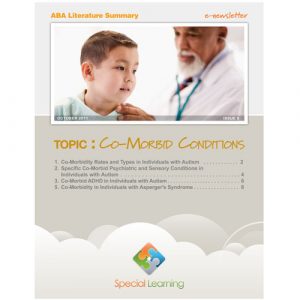The Assessment of Basic Language and Learning Skills- Revised (The ABLLS-R) is a skills-based system of assessment, curriculum, and tracking system that addresses the basic language and functional skills of an individual with autism and other developmental delays. It is used as a tool to help develop customized curriculums to teach language and other critical skills to children with autism or other developmental disabilities.
The ABLLS-R focuses on 25 skills in the areas of language, social interaction, self-help, academic, and motor skills that most typically developing children need prior to entering kindergarten. Expressive language skills are assessed using the Verbal Behavior method of behavioral analysis of language using a system developed by Dr. B.F. Skinner in his book, Verbal Behavior (1957). The assessment portion of this tool assists in the identification of skills needed by the child to effectively communicate and learn from everyday experiences. Results from this assessment are used to identify obstacles that prevent a child from acquiring new skills. This information is then used to develop a comprehensive language-based curriculum.
The original version of the ABLLS was developed by Dr. James W. Partington, Ph.D., BCBA- D, and Dr. Mark L. Sundberg, Ph.D., BCBA-D. It was revised in 2006 by Dr. Partington and is currently referred to as ABLLS-R. The revised version incorporates new task items and provides a specific sequence in the developmental order of items within the various skill areas. A significant contribution was made by Denise Senick-Pirri, SLP-CCC in the vocal imitation section. Additional improvements include a way to associate items with social interaction skills, motor imitation, and other joint attention skills, and to ensure fluency of acquired skills.

Co-Morbid Conditions – ABA Literature Summary
PRICE: $4.99
While ABLLS-R is most commonly used on children with autism and other developmental disabilities and delays, it can be used for anyone with delayed basic communication or life skills. The ABLLS-R assessment is conducted by observing a child’s behavior in each of the 25 skill areas. This is done by the instructor providing a stimulus to the child to assess skills based upon what a child does and does not do (assessment of behavior). Input from parents and other instructors is also taken into consideration.
The ABLLS-R is broken out into two separate books that work in conjunction with each other to accurately assess the child’s skills. The ABLLS-R Protocol is used to assess a child’s performance. The ABLLS-R Guide provides information about the features of the ABLLS-R, how to correctly score items, and how to develop Individualized Education Program (IEP) goals.
Copyright © by Special Learning Inc. All right reserved. No part of this article may be reproduced in any manner whatsoever without written permission except in the case of brief quotations embodied in critical articles and reviews. For information, contact Special Learning Inc., at: contact@special-learning.comParent Waitlist Program
November 02, 2023 | 12pm-1pm PDT

Being an RBT for me was extremely fun because where were you going to find a place where you can be completely silly without having to worry what people thought about you? This was the only job that made me feel like I could make a dramatic difference while being myself.
I also liked to be surrounded by people that had the same goals of wanting to help kids and the teamwork made the job much easier and more enjoyable.
Change and progress was the ultimate goal for our kiddos. The early intervention program was seriously only a miracle because I saw changes in the kiddos that from day one, you wouldn’t even recognize who they were.
Changes from being able to utter 3-4 words where they can only make a syllable from when they started, the behavior decreases in which kiddo that used to engage in 30-40 0 self-harm to only half, learning how to wait during games, table work where they use to swipe and drop to the floor if they had to.
My favorite was when the parents would tell us what amazing progress they were making at home. I used to tear up and felt for these parents so much because it was already difficult for them and now, they can trust and rely on ABA and the therapists knowing their goal was ours.
By Emma Rogers, BA, RBT

This is an independent SL Hotline that is part of our VCAT service. This hotline has no connection with any other association or membership group.
Got a question you want a BCBA or other ABA expert to answer?
Fill in this form and one of our professionals will handle your question quickly and confidently. You can expect a response in 24-hours or less.